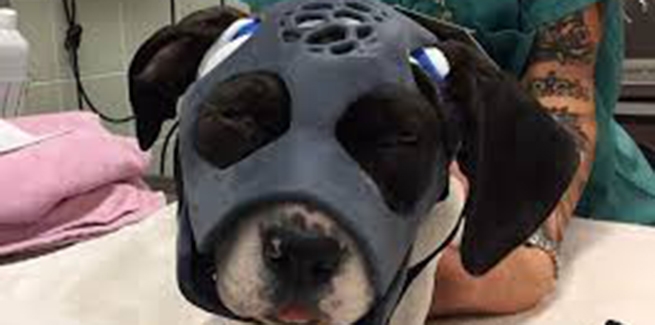3D-printed mask helps dog heal from horrific wounds

Meet Hannibal Lick-ter.
No, not really. The freaky-looking mask only makes her look like a canine version of a scary serial killer.
That’s Loca, a female Staffordshire bull Terrier whose skull was fractured in multiple places during a savage attack by another dog. Loca’s right zygomatic arch (cheekbone) and mandible (jawbone) were shattered, and her temporomandibular joint (TMJ) nearly destroyed. She was just four months old.
For Loca, it was a catastrophe.
For researchers at the University of California, Davis, School of Veterinary Medicine’s Dentistry and Oral Surgery Service (DOSS), it was a chance to try out some nifty new technology.
Loca’s injuries were severe, but her youth worked in her favor.
Because she was young, there was a good chance that the damage to her TMJ would heal by itself with natural bone growth. And that made her an ideal candidate to undergo treatment using a new 3D-printed face mask that DOSS developed jointly with biomedical engineering (BME) students at the UC Davis College of Engineering (COE). DOSS and COE had already been collaborating for years, with DOSS regularly tapping COE’s services to 3D print skull models to help with surgery preparation.
A natural outgrowth of that work led DOSS to collaborate with COE to design an apparatus to help in the healing process of maxillofacial fractures like Loca’s. The ingenious end result was the Exo-K9 Exoskeleton—a custom, 3D-printed mask for dogs that acts as a facial cast to immobilize their heads in cases where internal fixation isn’t a possibility.
As soon as Loca arrived at the hospital, researchers put the BME students on standby while they did a cone-beam CT scan to discover the full extent of her injuries. Once they determined she’d make a good test case, they performed a salvage surgery to remove bone fragments and sent word to the BME students to fire up the 3D printer.
While Loca was recovering from surgery, the BME students got to work. Using Loca’s precise measurements based on her CT scan, they 3D printed a custom-made mask that would fit her head exactly to optimize the healing process.
The next morning, Loca was fitted with the mask, the first of its kind. The healing began. The Exo-K9 worked beautifully.
Loca was able to begin eating soft food almost immediately, and pain meds kept her comfortable. In addition to the Exo-K9, Loca was fitted with a padded neck bandage to both stabilize a neck fracture that turned up on the CT scan and limit her range of movement during recovery.
For the next month, Loca had no access to toys, bones, or anything hard to chew. The mask and collar remained on at all times except when they were removed to allow her to eat and drink. She was kept on a soft diet until her injuries healed.
One month later, another CT scan showed that Loca’s fractures were healing nicely. As hoped, new bone was forming in the place of her former TMJ. The soft diet was replaced with a hard kibble diet to encourage chewing, which would help development of her new jaw bone.
Three months later another scan showed that Loca’s injuries had fully healed, and the new TMJ was coming along well.
Today, Loca continues to recover from her injuries, and all indications show that the Exo-K9 will prove to be an invaluable part of treating maxillofacial injuries in dogs.
Even if does make them look a little like a canine Anthony Hopkins.
Photo credit: (c) University of California, Davis, School of Veterinary Medicine



